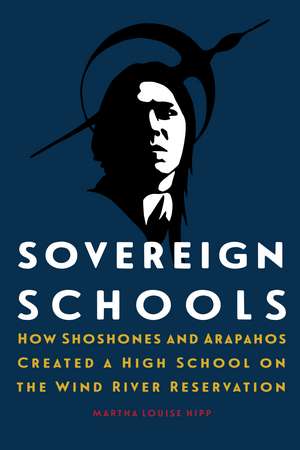Sovereign Schools: How Shoshones and Arapahos Created a High School on the Wind River Reservation
Autor Martha Louise Hippen Limba Engleză Hardback – 30 apr 2019
Sovereign Schools tells the epic story of one of the early battles for reservation public schools. For centuries indigenous peoples in North America have struggled to preserve their religious practices and cultural knowledge by educating younger generations but have been thwarted by the deeply corrosive effects of missionary schools, federal boarding schools, Bureau of Indian Affairs reservation schools, and off-reservation public schools. Martha Louise Hipp describes the successful fight through sustained Native community activism for public school sovereignty during the late 1960s and 1970s on the Shoshone and Arapaho tribes’ Wind River Indian Reservation in Wyoming.
Parents and students at Wind River experienced sustained educational discrimination in their school districts, particularly at the high schools located in towns bordering the reservation, not least when these public schools failed to incorporate history and culture of the Shoshones and Arapahos into the curriculum.
Focusing on one of the most significant issues of indigenous activism of the era, Sovereign Schools tells the story of how Eastern Shoshones and Northern Arapahos asserted tribal sovereignty in the face of immense local, state, and federal government pressure, even from the Nixon administration itself, which sent mixed signals to reservations by promoting indigenous “self-determination” while simultaneously impounding federal education funds for Native peoples. With support from the Coalition of Indian Controlled School Boards and the Episcopal Church, the Wind River peoples overcame federal and local entities to reclaim their reservation schools and educational sovereignty.
Parents and students at Wind River experienced sustained educational discrimination in their school districts, particularly at the high schools located in towns bordering the reservation, not least when these public schools failed to incorporate history and culture of the Shoshones and Arapahos into the curriculum.
Focusing on one of the most significant issues of indigenous activism of the era, Sovereign Schools tells the story of how Eastern Shoshones and Northern Arapahos asserted tribal sovereignty in the face of immense local, state, and federal government pressure, even from the Nixon administration itself, which sent mixed signals to reservations by promoting indigenous “self-determination” while simultaneously impounding federal education funds for Native peoples. With support from the Coalition of Indian Controlled School Boards and the Episcopal Church, the Wind River peoples overcame federal and local entities to reclaim their reservation schools and educational sovereignty.
Preț: 166.80 lei
Nou
Puncte Express: 250
Preț estimativ în valută:
31.92€ • 34.78$ • 26.89£
31.92€ • 34.78$ • 26.89£
Carte disponibilă
Livrare economică 02-16 aprilie
Preluare comenzi: 021 569.72.76
Specificații
ISBN-13: 9781496208859
ISBN-10: 1496208854
Pagini: 288
Ilustrații: 13 photographs, 2 maps, index
Dimensiuni: 152 x 229 x 28 mm
Greutate: 0.54 kg
Editura: BISON BOOKS
Colecția Bison Books
Locul publicării:United States
ISBN-10: 1496208854
Pagini: 288
Ilustrații: 13 photographs, 2 maps, index
Dimensiuni: 152 x 229 x 28 mm
Greutate: 0.54 kg
Editura: BISON BOOKS
Colecția Bison Books
Locul publicării:United States
Notă biografică
Martha Louise Hipp, PhD, is a retired psychologist and formerly served as psychologist for the Fremont County District 14 federally funded schools. She is a former president of the Colorado Psychological Association.
Cuprins
List of Illustrations
Preface
List of Abbreviations
Introduction
1. Precursors: Massacres, “Agreements,” Boarding Schools, and Strategies for Survival
2. Self-Determination: A Twentieth-Century Use for the Schools
3. Why the Wind River People Wanted a School: Late 1960s
4. False Promises: Mid-1971
5. The Non-Indian Fight over Indian Resources: Fluid Minerals and Hard Feelings, 1969–72
6. Reservation Organizations Oppose the School: Early 1970s
7. Indian School Opens: 1971–72
8. Indian People Speak, Face Retaliation: 1972–73
9. Fights in the Wyoming and Federal Courts: 1973–75
10. Control of Their Destiny: 1975–80s
11. As Seen from the Sun Dance Grounds: A Public School
Epilogue
Notes
Bibliography
Index
Preface
List of Abbreviations
Introduction
1. Precursors: Massacres, “Agreements,” Boarding Schools, and Strategies for Survival
2. Self-Determination: A Twentieth-Century Use for the Schools
3. Why the Wind River People Wanted a School: Late 1960s
4. False Promises: Mid-1971
5. The Non-Indian Fight over Indian Resources: Fluid Minerals and Hard Feelings, 1969–72
6. Reservation Organizations Oppose the School: Early 1970s
7. Indian School Opens: 1971–72
8. Indian People Speak, Face Retaliation: 1972–73
9. Fights in the Wyoming and Federal Courts: 1973–75
10. Control of Their Destiny: 1975–80s
11. As Seen from the Sun Dance Grounds: A Public School
Epilogue
Notes
Bibliography
Index
Recenzii
"Martha Louise Hipp's Sovereign Schools candidly illustrates, through exhaustive research and oral interviews, the resiliency of the Eastern Shoshone and Northern Arapaho Tribal Nations."—Cynthia Landrum, Middle West Reviews
"Sovereign Schools definitely belongs on the shelf of students of Indian history and the struggle for self-determination. Martha Louise Hipp ably gives the reader a front row seat to observe this effort."—Kenneth Zontek, Annals of Wyoming
"This is a case study that informs and inspires."—Bob Clark, Roundup Magazine
“Taking readers through the rocky terrain of state and federal government politics on matters of Indians in general and those specifically related to the Northern Arapaho on the Wind River reservation, Martha Hipp masterfully blends historical and personal accounts of Arapahos who, though scarred by Anglocentric government policies, persevered to assert their sovereignty in establishing their schools.”—Neyooxet Greymorning, professor of anthropology and Native American studies at the University of Montana
“I am reminded of the struggles, obstacles, barriers, and economic racism that the founders of Wyoming Indian High School endured; this only made them more determined to achieve their goal to establish a public high school. The grassroots effort of the Native community followed its own path to self-determination at Wind River.”—W. Patrick Goggles, former Wyoming state representative and former chairman of the Wyoming Indian School Board
